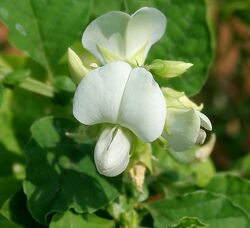Biology:Crotalarieae
From HandWiki
Short description: Tribe of legumes
| Crotalarieae | |
|---|---|

| |
| Crotalaria verrucosa | |
| Scientific classification | |
| Kingdom: | Plantae |
| Clade: | Tracheophytes |
| Clade: | Angiosperms |
| Clade: | Eudicots |
| Clade: | Rosids |
| Order: | Fabales |
| Family: | Fabaceae |
| Subfamily: | Faboideae |
| Clade: | Meso-Papilionoideae |
| Clade: | Genistoids |
| Clade: | Core Genistoids |
| Tribe: | Crotalarieae (Benth.) Hutch[1] |
| Genera | |
|
See text | |
| Synonyms | |
| |
Crotalarieae is a tribe of flowering plants belonging to the family Fabaceae. It includes rooibos (Aspalathus linearis), harvested for sale as a tisane.
Description
The Crotalarieae arose 31.2 ± 3.4 million years ago (in the Oligocene).[2][3] The members of this tribe consistently form a monophyletic clade in molecular phylogenetic analyses.[2][4][5][6][7][8][9][10][11][12][13][14][15] The tribe does not currently have a node-based definition and no morphological synapomorphies have been identified.[4][6] Several genera in the tribe produce quinolizidine alkaloids or macrocyclic pyrrolizidine alkaloids.[11][16][17]
Genera
Crotalarieae comprises the following genera:[18][19][20][21]
- Aspalathus L.
- Bolusia Benth.
- Calobota Eckl. & Zeyh.
- Crotalaria L.
- Euchlora Eckl. & Zeyh.
- Ezoloba B.-E. van Wyk & Boatwr.
- Lebeckia Thunb.
- Leobordea Del.
- Listia E. Mey.
- Lotononis (DC.) Eckl. & Zeyh.
- Pearsonia Dummer
- Rafnia Thunb.
- Robynsiophyton R.Wilczek
- Rothia Pers.
- Wiborgia Thunb.
- Wiborgiella Boatwr. & B.-E. van Wyk
References
- ↑ Wojciechowski MF (2013). "Towards a new classification of Leguminosae: Naming clades using non-Linnaean phylogenetic nomenclature". S Afr J Bot 89: 85–93. doi:10.1016/j.sajb.2013.06.017.
- ↑ 2.0 2.1 Boatwright JS; Savolainen V; Van Wyk B-E; Schutte-Vlok AL; Forest F; Van der Bank M (2008). "Systematic position of the anomalous genus Cadia and the phylogeny of the tribe Podalyrieae (Fabaceae)". Syst Bot 33 (1): 133–147. doi:10.1600/036364408783887500.
- ↑ "Evolutionary rates analysis of Leguminosae implicates a rapid diversification of lineages during the tertiary". Syst Biol 54 (4): 575–94. 2005. doi:10.1080/10635150590947131. PMID 16085576.
- ↑ 4.0 4.1 "Reconstructing the deep-branching relationships of the papilionoid legumes". S Afr J Bot 89: 58–75. 2013. doi:10.1016/j.sajb.2013.05.001.
- ↑ "Phylogenetic relationships of tribe Crotalarieae (Fabaceae) inferred from DNA sequences and morphology". Syst Bot 33 (4): 752–761. 2008. doi:10.1600/036364408786500271.
- ↑ 6.0 6.1 "Revisiting the phylogeny of papilionoid legumes: new insights from comprehensively sampled early-branching lineages". Am J Bot 99 (12): 1991–2013. 2012. doi:10.3732/ajb.1200380. PMID 23221500.
- ↑ "Molecular evolution of the Leguminosae: Phylogeny of the three subfamilies based on rbcL-sequences". Biochem Syst Ecol 24 (5): 365–378. 1996. doi:10.1016/0305-1978(96)00032-4.
- ↑ "Phylogenetic Relationships in the Papilionoideae (Family Leguminosae) Based on Nucleotide Sequences of cpDNA (rbcL) and ncDNA (ITS 1 and 2)". Mol Phylogenet Evol 8 (1): 65–88. 1997. doi:10.1006/mpev.1997.0410. PMID 9242596.
- ↑ "A phylogeny of the chloroplast gene rbcL in the Leguminosae: taxonomic correlations and insights into the evolution of nodulation". Am J Bot 84 (4): 541–554. 1997. doi:10.2307/2446030. PMID 21708606.
- ↑ "Towards a comprehensive phylogeny of legumes: evidence from rbcL sequences and non-molecular data". Advances in Legume Systematics, Part 9. Royal Botanic Gardens, Kew. 2000. pp. 1–20. ISBN 978-1842460177. http://www.kewbooks.com/asps/ShowDetails.asp?id=52.
- ↑ 11.0 11.1 "Evolution of chemical defense traits in the Leguminosae: mapping of distribution patterns of secondary metabolites on a molecular phylogeny inferred from nucleotide sequences of the rbcL gene". Biochem Syst Ecol 31 (8): 897–917. 2003. doi:10.1016/S0305-1978(03)00085-1.
- ↑ "A phylogeny of legumes (Leguminosae) based on analysis of the plastid matK gene resolves many well-supported subclades within the family". Am J Bot 91 (11): 1846–1862. 2004. doi:10.3732/ajb.91.11.1846. PMID 21652332.
- ↑ "Molecular phylogeny of the genistoid tribes of papilionoid legumes". Advances in Legume Systematics, Part 9. Royal Botanic Gardens, Kew. 2000. pp. 249–276. ISBN 978-1842460177. http://www.kewbooks.com/asps/ShowDetails.asp?id=52.
- ↑ "rbcL and legume phylogeny, with particular reference to Phaseoleae, Millettieae and allies". Syst Bot 26 (3): 515–536. 2001. doi:10.1043/0363-6445-26.3.515. http://www.bioone.org/doi/abs/10.1043/0363-6445-26.3.515.
- ↑ LPWG [Legume Phylogeny Working Group] (2013). "Legume phylogeny and classification in the 21st century: progress, prospects and lessons for other species-rich clades". Taxon 62 (2): 217–248. doi:10.12705/622.8. https://www.zora.uzh.ch/id/eprint/78167/1/Taxon_2013_217-248.pdf.
- ↑ Van Wyk B.E. (2003). "The value of chemosystematics in clarifying relationships in the Genistoid tribes of papilionoid legumes". Biochem Syst Ecol 31 (8): 875–884. doi:10.1016/S0305-1978(03)00083-8.
- ↑ "Alkaloids as taxonomic characters in the tribe Crotalarieae (Fabaceae)". Biochem Syst Ecol 18 (7–8): 503–515. 1990. doi:10.1016/0305-1978(90)90122-V.
- ↑ "Phylogenetic relationships of the tribes Podalyrieae, Liparieae and Crotalarieae". Advances in Legume Systematics, Part 7: Phylogeny. Royal Botanic Gardens, Kew. 1995. pp. 283–308. ISBN 978-0947643799. http://www.kewbooks.com/asps/ShowDetails.asp?id=81.
- ↑ "The generic concept of Lotononis (Crotalarieae, Fabaceae): Reinstatement of the genera Euchlora, Leobordea and Listia and the new genus Ezoloba". Taxon 60 (1): 161–77. 2011. doi:10.1002/tax.601014.
- ↑ "The generic concept of Lebeckia (Crotalarieae, Fabaceae): reinstatement of the genus Calobota and the new genus Wiborgiella". S Afr J Bot 75 (3): 546–556. 2009. doi:10.1016/j.sajb.2009.06.001.
- ↑ USDA; ARS (2003). "GRIN genus records of Crotalarieae". National Germplasm Resources Laboratory, Beltsville, Maryland. http://www.ars-grin.gov/cgi-bin/npgs/html/gnlist.pl?1540.
External links
Wikidata ☰ Q3776911 entry
 |

